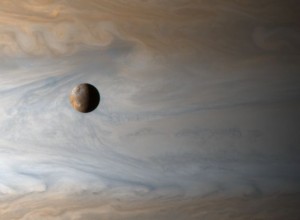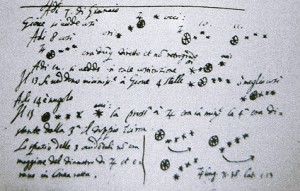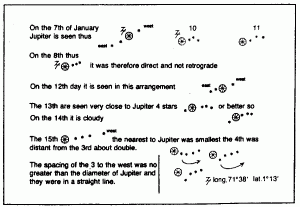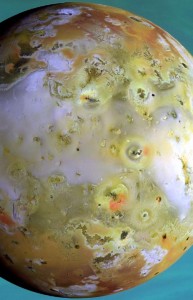
400 years ago, on January 7th, Galileo Galilei made his first observations of Jupiter. You can see his notes below. The big circle is Jupiter and the small dots are the specks of light he observed adjacent to the planet. Later observations showed that the specks did not stay in the same place, and lead him to realize that he was seeing moons orbiting the planet.


Galileo used a 33x telescope, which is pretty weak by modern standards, in fact you should be able to see Jupiter and it’s moons with a good pair of binoculars. Since the Catholic church at the time preferred the view that the Earth was the center of the universe, when Galileo published his observation he got into a bit of trouble. In his publication Galileo wrote:
On the 7th day of January in the present year, 1610, in the first hour of the following night, when I was viewing the constellations of the heavons through a telescope, the planet Jupiter presented itself to my view, and as I had prepared for myself a very excellent instrument, I noticed a circumstance which I had never been able to notice before, namely that three little stars, small but very bright, were near the planet; and although I believed them to belong to a number of the fixed stars, yet they made me somewhat wonder, because they seemed to be arranged exactly in a straight line, parallel to the ecliptic, and to be brighter than the rest of the stars, equal to them in magnitude . . .When on January 8th, led by some fatality, I turned again to look at the same part of the heavens, I found a very different state of things, for there were three little stars all west of Jupiter, and nearer together than on the previous night.
The above quote comes NASA’s page on the discovery of the Galilean satellites (for a full translation of the entire document go to: The Starry Messenger). The NASA page also has another neat quote, from Simon Marius describing how the moons got their names:
Jupiter is much blamed by the poets on account of his irregular loves. Three maidens are especially mentioned as having been clandestinely courted by Jupiter with success. Io, daughter of the River, Inachus, Callisto of Lycaon, Europa of Agenor. Then there was Ganymede, the handsome son of King Tros, whom Jupiter, having taken the form of an eagle, transported to heaven on his back …
For perspective, the image below, of Io’s surface, was taken by NASA’s Galileo spacecraft. Click on the image to get to the high resolution version.

The Galileo Mission website is a great resource about the mission to Jupiter and about Galileo Galilei himself. You can also find out what NASA’s up to with respect to Jupiter here.